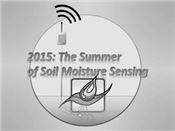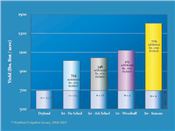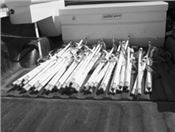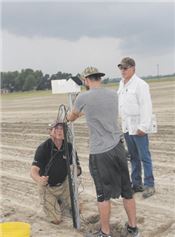|
2015: The Summer Of Soil Moisture Sensing

DR. JOE HENGGELER
PORTAGEVILLE, MO.
If you have ever wondered whether irrigating your crops based on soil moisture readings might improve your bottom line... you’ll have plenty of chances during the summer of 2015 to find out! A summer-long educational event, entitled 2015: The Summer of Soil Moisture Sensing (2015-SSMS), will afford you a variety of different opportunities to explore this very subject, ranging from Factsheets and articles in ag media on the very subject, field days for growers and consultants, field days for landlords, blogs, and a grand finale, end-of-summer conference that will feature some of the country’s premier experts on this subject, plus successful farmers who have made this BMP work for them.
Sponsored by the University of Missouri Extension, 2015-SSMS is the brainchild of Rick De DeLoughery, Mississippi County Regional Agronomist, and Joe Henggeler, State Extension Irrigation Specialist. DeLoughery, whose first full summer with MU will be in 2015, wanted to develop some irrigation extension outreach programs and Henggeler, who is retiring at the end of the summer, wanted to end his 40-year career working on a high-impact project. While at Texas A&M, Henggeler was the principal person that made surge flow an on-farm reality, and was the tip of the spear that got sub-surface drip irrigation (SDI) started in Texas, where now 1/3 million acres of SDI exist.
Soil Moisture Sensing: A Technology that Pays Dividends
After 40 years in the business, Henggeler’s contention is that there is not any other single irrigation BMP that will benefit an irrigator as much as the use of soil moisture monitoring. The practice is relatively inexpensive and the benefits can be substantial, making this single enterprise extremely economical. Figure 1 shows the level of yield advantage over dryland cotton yield (average yield from 2000-2011 was 700 lbs. of lint per acre) derived by using simple irrigation (no scheduling procedure), scheduling using a computer program (Arkansas Scheduler or web-based Woodruff irrigation charts), or scheduling based on the use of in-ground soil moisture sensors. The data comes from the Bootheel Irrigation Surveys, 2000-2011.
Note that the value of average dryland yield comes from 277 survey responses by irrigators between 2000 and 2011, and was about 700 lbs. of lint per acre. Irrigating without a scheduling method produced 314 more lbs. of lint per acre over the dryland yield. The use of scheduling with a computer program produced 346 and 423 more lbs. of lint per acre over dryland by using of Arkansas Scheduler and Woodruff charts, respectively. Using buried soil moisture sensors enjoyed a yield of 1,400 lbs. of lint per acre, which was 709 lbs. of lint per acre more than dryland! The economics are there.
Wireless Soil Moisture Sensing is an Option
The technology works especially well when it is performed wirelessly, but it doesn’t have to be as attested to 100s of Nebraska corn growers who use soil sensing devices hooked up to simple data loggers set up alongside their fields. Although many of the Cornhuskers have opted for wireless data retrieval, many still continue using the turn-row mounted data loggers which they check and download information to their thumb drives as they make their rounds. These irrigators, working with staff from their local water districts, have made soil moisture sensing work for them. Figure 2 shows a truckload of sensors ready to be installed. The really remarkable thing about the Nebraska experience is that around 800 irrigators have joined the project and not one of them has ever dropped out! That level of buy-in speaks volumes about the benefit of using this special irrigation BMP. One of the speakers at the conference will be someone with Nebraska University, where farmers, water districts, irrigation companies, and the university have joined forces to make irrigation more profitable for farmers and help conserve their precious water.
When wireless is opted for, as most Missouri users do, multiple sets of eyes can watch the soil moisture being extracted by the plants. The farmer, the consultant, and the landowner can come together as a team to make the right irrigation calls. Also, the information is available anywhere a cell phone signal is. For example, you can be at the 7th inning stretch at a Cards game and still be able to take a look at your field’s moisture conditions. Additionally, most of these systems can be set up to send you a text message based on a soil moisture parameter you have set up.
Bringing Educational Outreach to Bear
Nothing says farmer education as much as on-farm field days do. Approximately a dozen different soil moisture sensing companies have been invited to set up their demonstration units on a pivot-irrigated Bertrand, Mississippi cooperator’s farm, Randy Arington. A farmers and consultants’ field day will take place at the site where company reps will get a chance to explain their product’s features. A separate field day will take place for area landowners, as many don’t have the same strong farm background that their tenants do, but are still integrally involved in the decision-making in buying into soil moisture sensing.
Soil moisture monitoring is one of the three legs of the irrigation BMP triumvirate (the other two are surge flow and PHAUCET/Pipe Planner) that the United Soybean Board is promoting in LA, MS, AR, and MO in an attempt to increase irrigated soybean yields by 20 percent over the next four years. Field days addressing these BMPs are also being planned for this summer (2 in New Madrid & 1 in Butler County), and more information will follow.
Figure 3 shows a wireless sensor system being installed at the MU Rice Research Center near Glennonville, MO by Below Ag Services, LCC of Parma, MO (one of the companies taking part in 2015-SSMS).
Finally, the summer’s activities will be wrapped up with a one-day conference and tradeshow on wireless soil moisture monitoring to be held in mid-August discussing this technology. Several experts in this field from the US and Canada will be brought in as the keynote speakers. A tentative calendar of 2015-SSMS events is shown below.
FOR MORE INFORMATION:
• Dr. Rick DeLoughery (Area Agronomy Specialist & Mississippi County Program Leader) (573) 683-6129, delougheryr@missouri.edu
• Dr. Joe Henggeler (Missouri State Extension Irrigation Engineer) (573) 225-7986, henggelerj@missouri.edu
• T.B.A., Landlord Field Day (Bertrand, MO)
• T.B.A., Farmer & consultants’ Field Day (Bertrand, MO)
• Thursday, Aug. 13, Wireless Soil Moisture Sensing Conference (Miner, MO) ∆
DR. JOE HENGGELER: Irrigation Specialist, University of Missouri

Figure 1. Increase in yield over dryland from irrigation with no scheduling method, two different scheduling programs, and scheduling with soil moisture sensors.

Figure 2. A load of soil moisture sensors getting ready to be set out in fields of Nebraska cooperators.

Figure 3. A wireless soil moisture monitoring system with rain gauge being installed by Damon Dowdy of Below Ag Services of Parma, MO (kneeling) at the MU Rice Research Center near Glennonville, MO. Dr. Don Beighly, station director (clip board) and Steve Crosby look on.
|
|